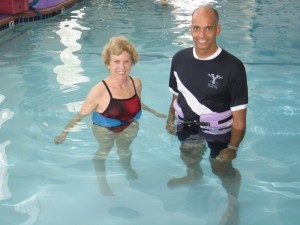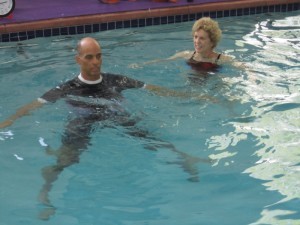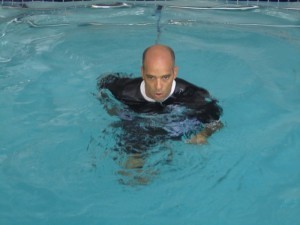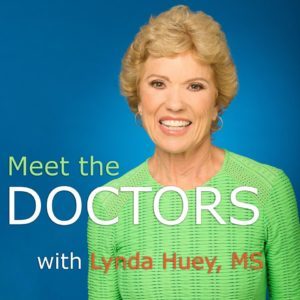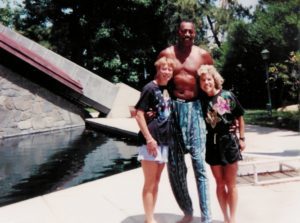Lynda Huey's Blog
October 9, 2024
The Many Ways We Miss Wilt – by Lynda Huey
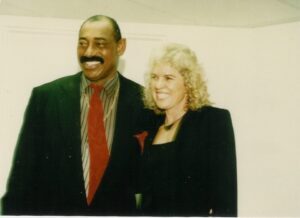
October 12, 1999, the day of Wilt Chamberlian’s death, was the worst day of my life. Suddenly, without warning, a huge Wilt-sized hole opened up in my Universe. He had been the center of my world for decades. For me, he was part of my daily life, whether I saw him or spoke to him or not. He was the center of my world. He was my family. He was the person I came home to after my world travels. He was the huge strong being that I orbited. Now what?
I moved forward as if sleepwalking through a haze, handling my brand new business CompletePT Pool & Land Physical Therapy. It was exactly a month old, and Wilt had been instrumental in bringing his high visibility to aquatic therapy. (The photo above was from the grand opening of the Wilt Chamberlain Rehab Center in Miami, FL, 1993 where we created a thriving aquatic therapy program.)
I don’t know why I thought I was the only person who could be hurting so badly at his loss. I’ve since learned how many people had Wilt deep in their hearts for many good reasons. We all lost someone special 25 years ago, and just like the day JFK was shot, we all remember exactly where we were when we heard the news.
What follows are the reminiscences from 11 people who were close with both Wilt and me. We shared our hearts about Wilt these past few days as I collected each person’s thoughts, one by one. This is my gift to those of you who wished you had known Wilt – or just known him better. It’s obvious we all loved him and had great times with him. Now I hope you have a few laughs, smiles, or even a tear or two a we remember this man who was ONE of a KIND!
Bobby Kersee, legendary Olympic track coach since the 1980s
I don’t think a lot of people knew what a kind, gentle giant Wilt was. How kind-hearted, how generous he was. But I’ve seen him in a different light. I really believe that without Wilt Chamberlain, I wouldn’t be where I am today if you look back at my career. It was Wilt who got me started, developing a team outside of a college team. I ran at the beach and Wilt was playing volleyball at the beach. I watched him play volleyball. He came to the UCLA track where I was coaching and he’d be working out on the track. I got to know him and he got to know me.
I asked him for $30,000 to start a club team outside of the college scene. He quizzed me. What were my expectations to win? How was I going to use the $30K? What’s important? What’s not important? What’s my financial budget look like? Why would you spend it that way? How is it going to benefit the girls? I told him about the great young athletes I thought could be developed into stars. We started Wilt’s Athletic Club in the ’81-’82 season. We took them to the Milrose Games in the Garden in NYC to showcase them. We had a great relay team and won, but Valerie Brisco Hooks ran past her teammate, missed the hand-off but finished the race. We were disqualified, but they saw our speed. Wilt got us a yellow-ish van with purple lettering, “We have the Wilt to win.” We could pick up athletes and get them to practice or take them to meets.
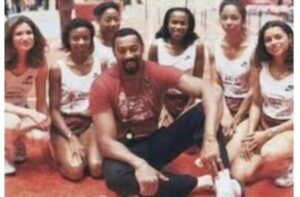
Wilt is the one that got me started financially on the club level. By 1984, we were the sprint team: Florence Griffith, Alice Brown, Jeannette Bolden, and Valerie Brisco-Hooks. I was a brash, young coach that believed in these athletes, looking for somebody who loved track and field. Wilt was enthusiastic about the gift he gave and how it turned into something. He was one of those “owners,” came out to the track and sat there. “Why’d you do that, coach?” questioning me. He felt I was doing it right, but was looking for me to find the reason why I was doing what I did. He had a coaching mind. He wanted to test it and test me. He taught me a lot, how to be confident, how to market things. A very wise man. He knew when to talk and when not to talk.
When he passed away, I was in the Atlanta Braves locker room working with their athletes. I had to sit in the hallway and cry. He was beyond a friend to me. He was hard on me as a coach because he invested in me. Looking back, I can understand why today. The intelligent man that he was, he saw something in me as a coach that I didn’t see in myself at that time.
Patty Van Wolvelaere, Olympic hurdler, member of Wilt’s WonderWomen
The last time I saw Wilt was in June, 1999 at the San Diego Rock and Roll Marathon. There’s always something that reminds me of him. We had so much fun together on and off the track. You and I met up with Wilt at the Jabberwocky in Encinitas to dance the night away back in mid-70s. When I talk to other members of the WonderWomen team, we talk about having a reunion, and that’s when he seems like he still should be here. I think about him all the time.
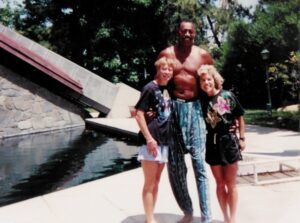
Patty Van Wolvelaere, Wilt, Lynda Huey at Wilt’s pool.
John Carlos, Olympic bronze medalist 200M, 1968
I played in the Canadian Football League in Montreal, so when the Olympics were there (1976), I knew my way around. I walked into a nightclub one night and they put the lights on me. Wilt was sitting in the corner. I went over to him and he said, “What you doin’ here? This is my town.” I said, “No, this is my town. You just visiting.”
I saw him the week before he died. He was driving down the 405 and broke down in some small car they gave him with his damn legs up in his nose. He was hot as hell, cussin’ and carryin’ on. I went up to his house, saw his pool, where you could swim outside from the inside. He told me at that time that he stopped taking the medicine they were giving him. Making him feel like a damn Zombie. So he stopped.
Only a week later, I was doing a radio show about what me and Tommie did at the 1968 Games. Had a headset on and I heard “Hold on.” I heard “Wilt Chamberlain.” Host went to commercial. When he came back, he said, “Wilt Chamberlain dead.” My heart stopped. He switched to talking about Wilt. He started asking me about Wilt’s personal life. I said, “You know what the word personal means? That means private.”
There was a lot to Wilt. Humanitarian, hands on. He took initiative to help girls in sports before any other guys even started to think about it.
Robert Klapper, MD, orthopedic surgeon
I think of Wilt all the time because the technology that I am now using that is AI and virtual reality began when I tried to take care of a 7’1” 300 lb. zero fat athlete. There was no prosthesis made for that dimension and that led me to explore using a CAT Scan to give the engineers in Indiana the dimensions with which to build a custom prosthesis for Wilt’s hip. This is the technology that we now are using and will be the future for joint replacement surgery. I think of Wilt as the inspiration for that technology.
Just like Kobe Bryant inspired the whole idea of biologic medicine by going to Germany for Orthokine treatment for his knee, Wilt absolutely inspired the world of arthritis surgery.
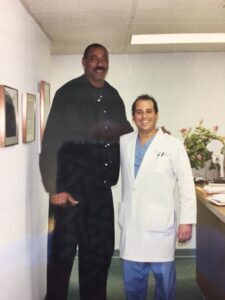
Wilt and Dr. Klapper
Willie Banks, Two-Time Olympian, Triple Jump World Record Holder
Wilt used to come to the track at UCLA where I was. He had been a triple jumper and he was impressed when I jumped a U.S. national record as a freshman at UCLA. He sponsored Wilt’s WonderWomen and my baby sister was on that team, so I heard so much about him. He was always my favorite basketball player; I was a major Wilt fan. As a kid, I was a Laker fan because of him. I always liked athletes who changed the sport and he sure changed basketball. No one can describe how impressive he was. His loud booming voice. He was always opinionated about sports, talked to me about how I could be a better athlete and a better person.
If I could talk to him now, I’d like to tell him of how he inspired me to do great things, how I’ve risen to be the highest-ranking person in track and field in the U.S. I have a seat on the World Athletic Council, which used to be the IAAF. Only 26 on the board, and I’m the one from the U.S. I wonder what he would think I should do next?
Bob “Vogie” Vogelsang, Volleyball player and coach
I met Wilt in Italy when he was playing for the Globetrotters and I was playing for the Washington Generals. I went up for a dunk that Wilt wasn’t expecting from me and got his attention. The next time I went up for a dunk, I ran into a solid brick wall. I felt every one of the bones of my back go crack, crack, crack. I felt really good after that.
When I heard Wilt had started playing volleyball, I invited him to come down to the beach. We were playing Gin Rummy. I said, “Wilt you’re looking at two cards, you’re cheating.” He denied it. Then he accused me of looking at two cards, and I said, “I’m not looking at two cards, I’m looking at three.” He wanted to know how I did that.
I was probably Wilt’s best friend, watching all kinds of sports at his house. We both did a lot of things in jest. We went to Super Bowl parties at Hugh Hefner’s house, bringing home girls to my tiny 1-bedroom apartment right on the beach. I guess they thought, “he’ not a millionaire like Wilt, but he’s a lot of fun.”
We went to play in a AAA tournament in Santa Cruz, but there weren’t any rooms for us at the Dream Inn overlooking Cowell’s Beach. They said they had the Honeymoon Suite open, so we took it. I stayed in the bed all morning with a few different women while Wilt chatted with people at the beach. Then Wilt got tired of me acting like Wilt and took over the bed and I went down to the beach. I think we took 3rd or 4th place and we beat the #2 seeded team. Wilt wasn’t really a AAA player, but he could win if he played with a AAA player and would listen to him. (Vogie was AAA and Wilt listened to him that tournament.) Wilt got his AAA rating in that tournament with me.
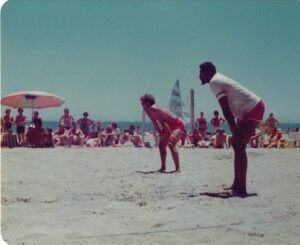
This was the first time I saw Wilt, playing with Vogie in the Santa Cruz AAA tournament. I didn’t know either of them yet. I was just a spectator on what then was my home court.
One time I was scheduled to play with Wilt in a tournament, then the #1 player, Larry Rundle asked me to play with him, saying, “We’ll win this tournament.” But I stuck with Wilt. When Wilt heard that I’d had turned down winning the tournament to play with him, I told him, “We’ll score more girls with us playing together than with us playing apart.” Wilt got that.
Wilt was smart in all the games he played, basketball, volleyball, and tennis. Of course, when he played with me, he never did anything wrong – everything was my fault.
Alan Silber, criminal defense attorney
Holy shit, is it really 25 years? Is there any possibility we’re getting old?
Wilt was such an unusual person. He was nothing like the public thought he was. I was glad to have that chance to live with you and him in his house to watch the 1992 Olympic Games. He was just a nice man. I never saw him be inconsiderate. The moment that I really remember was when we were watching Lithuania playing basketball, because Wilt loved Arvydas Sabonis. At half time Wilt began reminiscing about his loss to the University of North Carolina in triple overtime in 1957. He was sharing those thoughts with me, and he remembered every play. He said it was the worst loss that he suffered in his entire basketball career.
George Starke, Offensive Tackle, Washington Redskins 14 years
Wilt’s favorite pastime other than chasing women was playing Yahtzee, a dice game. He and I played racquetball together. It’s a game where you have to control the center of the court. I had to move that Big Muthafucker out of the center of the court. Now here I am a pro football player that’s used to banging people out of the way. We both were banging each other like crazy in a court that isn’t sized for a 7’2” 280 lb. man to play a 6’5” 250 lb. man. I think he liked the fact that I could bang as hard as he could bang. We would fight it out and have a good time playing racquetball. I spent at least 10 nights with him, hangin’ out, playing Yahtzee. Mostly it was a guy thing. He liked that we could bang each other hard and it was nothing personal when we wore each other out on the racquetball court. And he could PLAY some Yahtzee!
Tracy Sundlun, Coach of Wilt’s WonderWomen, Co-Founder of the Rock ‘n’ Roll Marathon Series, President/CEO of World Athletics Road Running Championships, San Diego 2025. Head Manager of the U.S. Olympic Men’s Team 2016.
I think of Wilt shockingly often. Not a week goes by that I don’t have a conversation with somebody about him, not about sports, just normal things. When I watch a basketball game, it pisses me off that he doesn’t get the recognition for being the seminal athlete and player in that sport that he was.
Wilt raised the profile of women’s sports. He recognized how great our women athletes were, he supported them and he promoted them. Not just track and field where he had both Wilt’s WonderWomen in the 1970s, then Wilt’s Athletic Club in the 1980s; he had Wilt’s Little Dippers, a women’s volley ball team. Wilt just naturally did things that others wouldn’t do. He didn’t live or think in a box; he had a global view. I met him at the UCLA track and we immediately became friends. He supported Wilt’s WonderWomen, our current team. He became a celebrity founder of the Rock ‘n’ Roll Marathon series and when we needed some positive press, he stepped up. ESPN nominated Wilt into for the top male athlete of the 20th Century. So all the media wanted to talk to him. He said, “I will talk to you, but only if you write about my marathon.” We delivered a great event that grew into a series. It was the #1 running series in the world for almost 20 years. That probably wouldn’t have happened without the platform Wilt had to create media attention.
He was bigger than life. I don’t think there’s anybody today that has that stature, except maybe Taylor Swift. His impact on women’s sports is evident today, and they don’t even know that.
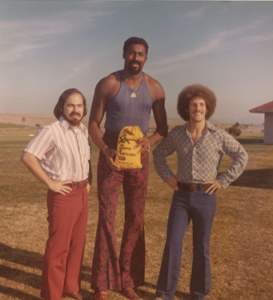
Left to right: LeRoy Perry, Jr., D.C., Wilt, Tracy Sundlun
Robert Lipsyte, Sports Journalist and Young Adult Fiction writer
I thought about Wilt a couple of weeks ago. He as is often compared to Bill Russell to his disadvantage. Wilt was brute force; Bill was a person of delicacy. But as I thought about that, he never hurt anybody. A man of that size back then when others weren’t that big. He played with a kind of restraint, which was incredibly admirable. His sensitivity and sweetness never transcended the public consciousness. I always gave him the benefit of the doubt because you were his friend.
LeRoy Perry, Jr., D.C, Team Doctor for Wilt’s WonderWomen
Wilt Chamberlain was one of the most important people in my life. He and coach Tracy Sundlun appointed me the team physician for Wilt’s WonderWomen in 1975. As a result of treating the female athletes, I met many international male athletes (the boyfriends of the girls). This began my interest in the sport of track and field. Steve Williams was the fastest sprinter in the world at that time, so when one of his friends told people to see me if they got hurt, that’s what started to happen. I attended the 1976 Olympic Trials with Tracy and Wilt and their athletes. Steve Williams pulled his hamstring and asked me to help him. The medical establishment was anti-chiropractic and wouldn’t let me treat patients in the medical tent. Steve and I had to go to a weeded area behind the medical tent so I could evaluate and treat him. Being the fastest U.S. sprinter, the press followed him. They took photos that appeared in the major American and European newspapers. That started a controversy that the AMA never forgot.
Wilt and I co-founded the Foundation for Athletic Research and Education (FARE) a 501 (c) 3 nonprofit for the purpose of doing research with athletes on how to improve their health and apply that to our general population. In many ways, Wilt was my mentor, friend, and greatest supporter. He not only started my career, he made it meaningful.
April 3, 2019
Bill Funderburk Rows Henley Regatta After Hip Surgery
From 1980 to 1983, Bill Funderburk rowed for Yale in the heavyweight crew boat. The first seat closest to the coxswain is called “Stroke,” and it was Bill’s job in his junior year to hold that first position in one of the varsity boats and establish the rhythm of the rowers. Every year, the Yale-Harvard race was the annual highlight. If the crews won there and had completed a stellar season, Yale funded a trip to row in the Henley Royal Regatta, the most prestigious place in the world for rowing just as Wimbledon is that place for tennis. Film goers were introduced to that world of privileged exclusivity in “The Social Network.” Bill and each of his teammates participated at least once in that illustrious race on the Thames, 30 miles from London.
Bill had a torn labrum in the hip and the joint was bone on bone. He was plagued with back pain and dysfunction associated with the hip, and it was painful to sleep, bend or sit. In mid-December, 2012, Bill had total hip surgery. Then, after non-stop support from his wife Felicia, he came to CompletePT in early January to begin his comeback. His goal was to meet a qualifying standard time for 1000 meters on a rowing machine ergometer by May 1st so that he could return this July with his Class of ’83 Yale teammates in a masters race at Henley.
Bill did twenty pool sessions with us. A large, muscular athlete, Bill needed to wear two flotation belts in order to be upright in the pool without his chin touching the water. His therapist strapped a CompletePT belt on him, the most buoyant of the belts and also added a second belt to counteract the downward pull of his muscle density. He did deep-water running and powerwalking for aerobic fitness in our 7-feet deep pool. At 6’4″, he needed our newly-remodeled pool — he would have been dragging his feet on the bottom of the old one that was only 6′ deep. Then he stretched, using our double bar system that protected him from violating his total hip surgery precautions regarding movement. Next he did some kicking exercises to strengthen core and leg muscles. In shallow water, a flotation cuff was put around his ankle to help increase the range of motion of that post-surgical hip as he did standing leg exercises. Our licensed physical therapists will determine when it is time to switch to adding resistance pieces around the ankles to increase strength.
During the pool therapy, he regained much of his strength and mobility. On May 1st, he beat the qualifying standard by four seconds and earned his seat in the boat!
Bill rowed out of the iconic Long Beach Rowing Association and received support to get actual meters on the water, something crucial to regaining a sense of balance and being able to blend with his Yale class teammates during the week of training prior to the race. But his hip grew stiff from having stopped his physical therapy. Bill returned to CompletePT for the next phase of his rehabilitation. He sensed he would need to fight for the remaining range of motion and athletic capability that was still not quite available to him. He trained hard both in the pool and on the water with LBRA and joined his 1983 Yale teammates in Henley for the race on July 13th.
“The race is so much more than just about rowing,” said Bill. “It’s clearly as much of a mind and spirit journey as it is a physical journey. It’s not about me but every one of the guys in my boat. I had to learn to surrender to and trust my teammates, and they had to do the same. Every second you’re rowing with seven other people, you have to be synchronized with them, be part of something greater than being an individual. That was what I yearned to relive and I knew that’s what all eight of us were going to get to relive.”
There was a time between 1977 and 1984 when Yale had a dynasty in the collegiate heavyweight rowing world. Undefeated seasons were the norm and the expectation not the exception. All of Bill’s teammates had rowed at Henley previously and they were all elite college oarsmen, even those, like Bill, who were walk-ons (not recruited) in their freshman year. Everyone had had at least one undefeated season. They were all looking forward to experiencing the Henley Regatta again.
Henley is unique in that only two boats can fit on the Thames at a time, so each boat is going heads up with only one other boat. “There are boats there from around the world,” said Bill. “It’s a great chance for rowers who have stayed in shape and who want to relive old memories of having rowed at what is viewed as the pinnacle of rowing.”
Bill had learned over his rowing career that you never knew if your spirit was going to be broken during a race and that what the mind was saying you could or couldn’t do was the most important thing. His hip was tight prior to the race. Another teammate who had had heart surgery the year before was experiencing atrial fibrillation on and off.
“We could have been a little more conditioned,” said Bill. But none of that mattered. “The state of mind was: We don’t care about your hip – that’s a lame excuse. Or heart. That doesn’t matter either. We’re going to dig down as a team and find whatever strength is required.”
The pace of a rowing race is similar to that of a swimmer going longer than 100 meters where the first lap can be the fastest, then you settle into a pace where you can stay aerobic for 3 minutes to 3 ½ minutes before using everything you’ve got for the finish.
Race day had a slight tail wind and the water was very still. In the semi-finals, Yale rowed against Quintin Boat Club. The first 20 strokes of a race is where rowers like to establish their fast speed and dominance over their opponents. After the first minute, the Yale ’83 crew — rowing as the Bulldog Rowing Club — was ½ length ahead, but then their opponent hit a good rhythm and reduced the deficit to three feet.
“When a crew starts to row back on you, they can break the other team down mentally,” said Bill. “We saw them push ahead by a few seats, but then all of us rose up together and dug our oars in harder. We collectively summoned up the courage to push back against the pain of such high-intensity work. We rowed back through the other crew to win it by a canvas. That’s like winning by a head in horse racing.”
As it turned out, the semi-finals race proved to be the highlight experience for the Bulldogs. They got to re-experience the sensation of fighting back with all you’ve got and winning.
The finals were against Crabtree Rowing Club, which had multiple classes of Cambridge University rowers. Half the team members had rowed in the 1976 or 1980 Olympic Games and two were Olympic medalists. They had been practicing together twice a week for six months. By contrast, the Yale alumni team had rowed together in the boat for just one week.
“But put aside those excuses. They just beat us,” said Bill. “We stayed even with Crabtree for the first 45 seconds to a minute. At the midway point, we were down by two-thirds of a length and that surprised them. They had won their previous races easily. We were making them work for the win. They gradually pulled away. We tried to take the stroke rate up and challenge them, but they ended up winning by a length and a half.”
Yale’s times were very competitive. They won their semi-final in a time of 3:11, and in the final on the same day they rowed an even faster time of 3:08, one of the fastest times recorded by any age group boat during the whole regatta.
Bill’s former roommate at Yale, Jim McGlone, rowed Stroke on the boat this time at Henley. (See him at the front of the boat in the photo above.) Bill shared Jim’s comments:
“The famous boat builder George Pocock described rowing the following way: ‘It’s a great art, is rowing. It’s the finest art there is. It’s a symphony of motion. And when you’re rowing well, why it’s nearing perfection. And when you near perfection, you’re touching the Divine. It touches the you of yours. Which is your soul.’ So we returned to Henley a band of brothers to enjoy our slice of heaven. As we age we accept each other for our human frailties and enjoy even more the symphony of motion Pocock so eloquently wrote about. I believe Bill was motivated by this feeling and I thank CompletePT for guiding my friend through his recovery which enabled us all to touch the divine for that brief moment!”
Home from the excitement of Henley, Bill has begun the final phase of his rehab program at CompletePT, where he will be expected to perform running and jumping exercises in chest-deep water before the end of his treatment.
William W. Funderburk, Jr., partner at Castellón & Funderburk LLP, graduated from Yale University and from Georgetown University Law Center. He is admitted to practice law in California, District of Columbia and Pennsylvania. Bill was the first African-American rower for Yale to go to the Henley Royal Regatta.
Lynda Huey, M.S., founder of CompletePT and Huey’s Athletic Network, is a former athlete and coach whose own injuries led her into the water to find fitness and healing. She was educated at San Jose State University where she starred on the track and field team during its golden years. Lynda is the author of four books on water exercise and water rehabilitation.
December 27, 2018
Podcast now live
Lynda has launched a podcast – Meet the Doctors. Head on over to MeetTheDoctorsPodcast.com to hear the very latest.
January 22, 2018
A 21st Century Clinic for Patients with Inflammatory and Auto-Immune Conditions
When you walk in the door of Attune Health, it’s very soothing. It stops you in your busy life. You slow down and think to yourself, “OK, I’m here, I’m safe.”

That’s exactly what two top rheumatologists in Beverly Hills were aiming at when they planned Attune Health. Dr. Swamy Venuturupalli (often called “Dr. V”) and Dr. Daniel Wallace built their new suite with the patients in mind.
Dr. Venuturupalli says, “The patients need to come to an environment where they feel safe, where they can check their worries at the door and feel they are part of the team. The philosophy behind our clinic is to create research-based solutions for auto-immune and inflammatory conditions. We knew there would be collaborations going on between the patients and doctors, between the patients and the staff, between the staff and themselves and between the doctors and themselves, so the clinic has been built for just that. Plus we have the capability of conferencing in colleagues and patients all over the world through our HIPAA-compliant (patient privacy laws) video conferencing software. Attune Health is the physical manifestation of a vision of practicing medicine.
Auto-Immune Made Simple
So what is auto-immune disease anyway? The immune system is a complex organization within the body that is designed normally to “seek and destroy” invaders of the body, including infectious agents like bacteria and viruses. But when the immune response of the body turns against its own tissues or cells, that’s an auto-immune condition. Autoimmune diseases are more frequent in women than in men. The estrogen of females may influence the immune system to predispose some women to autoimmune diseases. Furthermore, the presence of one autoimmune disease increases the chance for developing another simultaneous autoimmune disease. OK, so how does that happen?
Dr. V explains, “There’s a breakdown in the process called tolerance and the immune system starts attacking the patient’s own body. Immune tolerance is a well-known biological process by which the immune system of healthy people ignores all of their own cells so that their own DNA is not attacked by the immune system. It knows not to. Everybody’s born with tolerance.”
Before birth and throughout childhood, the immune cells, the T cells, go through this process of tolerization in the thymus gland located behind the sternum and between the lungs. The thymus is instrumental in the production and maturation of T cells, a specific type of white blood cell that protects the body from certain threats, including viruses and infections. The thymus produces and secretes thymosin, a hormone necessary for T cell development and production. Throughout the childhood years, white blood cells pass through the thymus, where they are transformed into T cells. Once T cells have fully matured in the thymus, they migrate to the lymph nodes, which are groups of immune system cells throughout the body, where they aid the immune system in fighting disease. When the thymus gland’s work is done, each person has developed a repertoire of T cells that stay with him through life. T cells that don’t work correctly went through the maturation process in the thymus gland, but they’ve forgotten what they learned for some reason. Something happened that broke down that memory of tolerance and they lose some of the abilities to discriminate between one’s own tissues and outside invaders. They begin fighting the body’s own tissues, and that’s auto-immune disease.
A walk through the clinic finds the following:
• Nine treatment and evaluation rooms
• An in-house lab that is certified to perform routine blood testing, providing patients with results in real time and posting them with comments on their secure web portal. Patients can view and print their lab results at their convenience.
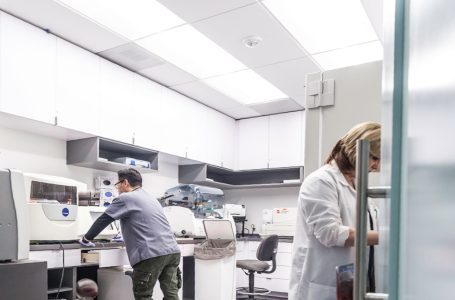
• Functional medicine and nutritional testing. Nutritional deficiencies have been linked to chronic conditions, so Attune’ s nutritional expert provides recommendations based on the patient’s highly-specialized test results.
• A movement and therapy room that incorporates cutting edge experiences such as Virtual Reality.
• Telemedicine visits, which are possible for some long-distance visits when the patient is traveling or off site.
• An infusion center where patients can receive biologic therapies that zero in on a specific molecule or other target. Experienced nurses administer over twenty approved infusion substances as well as any that are being offered experimentally as part of a research study conducted on the premises.
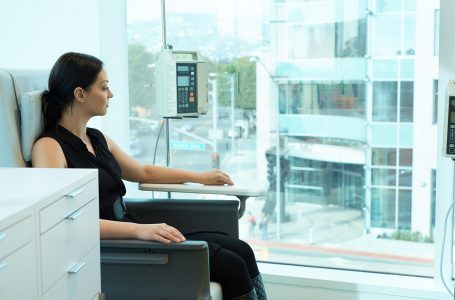
• A concierge wing that provides the quickest path to recovery by using Attune’ s technical abilities and access to leading consultants as needed to solve the patient’s challenges, all the while using their whole body/whole person approach. The Attune team carefully screens and selects a small group of concierge patients they believe can most benefit from their expertise.
Concierge Wing

Dr. V continues, “The concierge aspect of the practice allows us to provide a higher level of care to a particular patient who needs us to put together a team around their specific auto-immune or inflammatory problem. The problem might be someone who has an auto-immune condition that has been hard to control using normal methodologies. We pull together the current status of what’s been tried and what has failed through the years of helping this patient. Following that, we figure out what other organ systems might be involved or might be contributing to the patient’s lack of progress. Next, we consult with other doctors or specialists in those areas and we would bring them into our suite so all of us can put our heads together. We’re able to solve a problem for the patient as a team. For example, we might want to start physical therapy or we might want to have a nutritional program put in place for the patient. The involvement of the physician in those aspects of the patient’s care is a critical element that is missing in most PT and nutritional programs because everyone is working in their own bubble and nobody’s really putting it together for the patient. That’s basically our concept: bring the best and the brightest together with our physician expert quarterbacking the process so we can achieve the best outcome possible.”
Attune Health as a Research Center
Dr. V points out that there are several types of research performed at Attune Health. One type that is very important, Outcomes Research, depends on the participation of the patients. People with diseases such as lupus, Sjogren’s, or scleroderma are followed over time while the staff takes research measurements on their condition. Between visits, when the newest technologies like biosensors are used, it can be seen how they’re doing over a long period of time. Thus the researchers at Attune can learn about what these diseases do and what conditions might worsen the disease and what might make it improve.
Then there are Drug Therapeutic Trials. These are sponsored by the pharmaceutical industry to test out new drugs for certain conditions. If some of Attune’ s patients are failing the standard therapy, the doctors will consider some of these experimental treatments.
Investigator-initiated Trials go something like this. A doctor might say, “In my practice, I see that patients respond to Drug X, but Drug X is not FDA approved for Condition A, which my other patient has. I’d like to try it on him.” The doctor petitions the drug company for free drugs, he writes a proposal, and he might get philanthropic support from the community or from research foundations. Then the doctor runs the clinical trial, not the pharmaceutical company. Right now, Attune Health has one such investigator-initiated approved trial underway and one more coming up soon.
New technologies is another thing Attune is working to bring into the clinic. They are trying Virtual Reality (VR), working with a start-up company that is developing software for mindfulness, relaxation, and also doing biofeedback using VR. When you’re wearing the VR glasses, you’re immersed in a different world. Then you can add audio to it and have a meditative experience like being on a beach, hearing the waves, and listening to a guided meditation. Since research has found chronic mental stress to be a trigger for autoimmune diseases, finding ways to provide relaxation and stress-free experiences could prove valuable.
Lastly, Attune is creating a Research-based Wellness Program that they will have tested out and shown that it improves outcomes in diseases like lupus and rheumatoid arthritis.
Attune Health is an academically-oriented practice in which all the providers are researchers. Dr. Wallace is the trailblazer who has been in clinical research for many years. He’s published many articles and written many book chapters, and although research is traditionally conducted in universities, Dr. Wallace has proven you can do good research in a private setting. Dr. V is following his lead and has published a fair amount as well. The two new rheumatology associates, Daphne Scaramangas-Plumley, MD and Christine Lee, MD, are interested in conducting research and give Attune Health more fire power in doing clinical outcomes research.
Advances in Technology
To Dr. V, the most exciting of these outcomes studies is the Lupus Biosensor Project, where they will be putting a FitBit onto the patients who have lupus and following them for three months. FitBits are activity trackers, wireless-enabled wearable technology devices that measure data such as the number of steps walked, heart rate, quality of sleep, steps climbed, and other personal metrics involved in fitness.
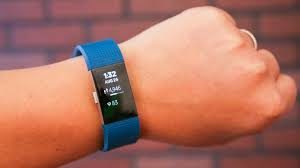
“We’ll also ask them questions on a weekly basis about how they’re doing, what are their stress levels, and we’ll monitor their sleep,” says Dr. V. “I’m really curious to see if there’s a correlation between stress, sleep, and how they’re doing, and I want to show that with real patients in a clinical setting. We would contrast that to the patients who aren’t wearing the biosensor (FitBit), who simply following the usual standard of care.”
“We’re at that very interesting stage where these potential technologies may really change the way we view disease and health.”
-Swamy Venuturupalli, MD
The physicians at Attune Health typically see their patients once every month or two, but what happens between visits was an area that was previously never addressed. Now with technology, they potentially have the ability to address that part of the patient’s life and the activity of their disease. Heart rate variability can give the doctors an idea of how much stress the patient is dealing with. They are doing the preliminary research now, so once they are able to show the new technologies add something and the patients are doing better as a result of them, then they should become standard of care. Dr. V sums it up: “We’re at that very interesting stage where these potential technologies may really change the way we view disease and health. We can now measure things in real time that we previously had only subjective ideas about. A patient tells us they’re not feeling well and their lupus is flaring – how to you define a flare? The FitBit will help us see if there are any signals we can pick up in terms of stress, lack of sleep, or activity that might predict that a patient is doing poorly before they actually complain to the doctor.”
“Now with wired homes and wired cars, the potential is boundless. You can have weight machines that communicate with your phone. We can get that data. We can get data on what you eat. New technologies sense what’s on your plate and give you a quick analysis. It knows the weight and the calories and the nutrient density and what vitamins you got and didn’t get. We can watch and tweak a few things and that can help.”
Dr. V quickly says that he’s not a “geek,” but that he’s not afraid of technology, and that he’s taking the lead on implementing new technologies into the clinic.
“Technology has entered every aspect of our lives in a short period of time. The more we utilize it, the more we reach our goals. But technology isn’t going to solve our problems; it’s how we apply it that’s going to solve the problems. Artificial intelligence (AI) is here to help. We’re generating billions and trillions of bits of information on a daily basis, and now there are computers that can make sense of all of it. I’m hoping AI will significantly accelerate medical discoveries so that we don’t have to wait for hundreds or thousands of patients to get sick before being able to recognize a pattern of cause and effect. With these AI systems, we should be able to get that sort of insight quickly.”
Dr. Venuturupalli, a Glimpse of the Man

Dr. Venuturupalli with Indian Premier League cricketer Dinesh Salunke at Cricket nets.
“I became an American citizen this year,” says Dr. V. “I grew up in India where I played cricket and badminton. Then I benefitted from getting my higher education in the United States. Now that I have a team here at Attune Health, I feel much better about being able to achieve the really high goals we have set for ourselves, which is to cure auto-immune diseases. The initial work we’re doing is that of curating our program and bringing together the right people who can collaborate with us. It’s still a work in progress. Through my years of study and professional work, I’ve realized that one of the prerequisites to achieving success is to dream big.
“I’m married with two kids, ages nine and twelve. I have a physician wife who is in public health, working for the County of Los Angeles. Silver Lake is a good place for us to live, away from the pressure of the West Side. And if I get in early enough, the commute isn’t bad. The kids are into sports. I like soccer a lot, so I’m into coaching and refereeing their games. On weekends we go for walks or hikes in Griffith Park – you can get lost there. Then there’s the L.A. River, which is nice. It’s probably a little rougher than most people would want, but I’m fine with it.

“One of my sisters is in San Francisco and the other is in New York. My wife’s family is all in New York. We have a basic family life. Since we don’t have family in town, the kids get to see both of us every evening – finishing up homework, having dinner, and dealing with stuff at home. I exercise late in the evening. I go for a run or I go to the gym.
We love to travel to different places as a family, and usually do a national park once a year and an international destination when possible. India remains a special place for me and I try to go once a year.”

Dr. V was invited by the Saifee Hospital and Research Center, one of the leading hospitals in Mumbai, India, to give a lecture, “Rheumatology in the 21st Century: Lessons from Experiences in RA Research for Lupus.”
“I get most of my reading done on audio books while I’m driving or at night when I’m winding down. I’ll listen instead of making my eyes keep working like they’ve done all day. I’m catching myself doing too much work at home, so that’s something I’ll cut out on as we fine tune what we’re doing at the clinic.”
More than anything, I want people who have auto-immune or inflammatory conditions to know that I think there’s hope around the corner.
–Swamy Venuturupalli, MD
“There’s a lot of research and new technologies that I think will change the game. I’m really excited about that. We’re learning so much about nutrition and wellness and how those factors can impact auto-immune diseases for the better. In the next five to ten years, I think we’ll radically change how we’re treating these conditions, and I’m excited to be part of that change.
“More than anything, I want people who have auto-immune or inflammatory conditions to know that I think there’s hope around the corner.”
Water Rehab Specialist, Lynda Huey, MS, earned a bachelors and masters degree from San Jose State University where she also starred on the track and field team. Her own athletic injuries led her into the water where she learned to cross train and speed the healing of injuries. She has written six books on aquatic exercise and rehabilitation, books that are considered the foundation of aquatic therapy world-wide. Lynda is President of CompletePT Pool & Land Physical Therapy in Los Angeles.
September 29, 2017
Aquatic Therapy for Lower Back Pain
“Aquatic therapy has made me more independent.” This is a quote from a former patient who had approximately twelve weeks of aquatic therapy for low back pain. She had a history of lumbar spine surgery in 2012 but continued to have significant pain and decreased activity tolerance, which eventually put her in a wheelchair. She had tried land physical therapy at other facilities; however, many of her exercises were done in her wheelchair and did not allow her to reach her personal goals. She was eventually referred to aquatic therapy, which she reported was her “last hope.” At the end of the twelve weeks, this patient no longer had radiating pain, which allowed her to reduce the amount of pain medication she was taking. This reduction of pain allowed her to participate in both functional and recreational activities, such as walking with a walker and standing long enough to cook a meal with greater ease and improved balance.
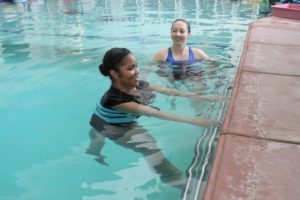
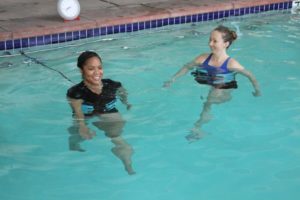
Back patients hold the side of the pool until they develop enough core strength and balance to perform deep water intervals on a tether.
The water was a perfect environment for this patient and for many others with low back pain. Patients with low back pain often start their course of rehab in the water, as there is less impact on the body. The buoyancy of the water helps patients move their limbs more easily through the water, whereas on land they are working against gravity. The buoyancy of the water also decreases weight-bearing, which in turn reduces stress through the joints and intervertebral discs. There is a 50% reduction in weight-bearing in waist-deep water, 75% in chest-deep water, and 100% in the deep end of the pool.
Common diagnoses we may encounter include stenosis, sciatica, degenerative disc disease, and lumbar strain. These diagnoses will help determine a plan of care and can give clues as to which exercises may be painful for these patients. For example, a patient with a diagnosis of stenosis may have increased pain with lumbar extension. Or those with neural tension may have increased pain with forward leg swings or quad extensions at 90 degrees of hip flexion. Post-surgical patients are often referred for pool therapy as well. Common surgical procedures include artificial disk replacement, discectomy, laminectomy and fusion. Be sure all incision sites are fully healed before these patients enter the pool. Also, be mindful of any specific instructions on the prescription.
A typical session for a patient with low back pain will include both deep water and shallow water exercises. For deep water exercises, our patients start with a series of Deep Water Intervals (DWIs), including Bicycle, Powerwalk, and Flies, while holding onto a bar along the side of the pool. Those without bars can hold the coping on the side of the pool. Holding onto the bar or coping allows the patient to maintain trunk stability while focusing on learning correct form, as well as allowing the rehab specialist to assess the patient’s tolerance to the exercises. Once a patient demonstrates good form and control while holding onto the bar, they are ready to transition to the tether. Performing DWIs on the tether incorporates use of the upper extremities and calls for increased core activation to maintain proper form. After DWIs, we stretch. Hamstring stretching may be done in deep water or shallow water and is important for patients with low back pain.
Shallow water exercises typically include both lower extremity and abdominal strengthening exercises. For the lower extremity exercises, patients start by holding onto the bar to improve trunk stability. Make sure that the patient is isolating the proper muscles and keeping the core engaged, as to prevent trunk sway and compensations. A common mistake is activating lumbar spine extensors instead of glutes and hamstrings during Leg Swings. Also keep the depth of the water in mind – if a patient has poor tolerance to weight-bearing, move them to deeper water. If they are still having significant pain, a flotation belt may be worn to off-load the lumbar spine even further.
Once the patient displays proper form and muscle activation without resistance, resistance fins may be used to improve strengthening. Another way to progress lower extremity exercises is to perform them freestanding. This forces the patient to further engage his or her core muscles to maintain upright position, as they no longer can rely on the bar. This also improves single leg balance and glute strengthening on the stance leg.
We also utilize a series of upper extremity exercises that, while incorporating arm movement, forces the patient to engage his or her core muscles. The patient typically starts these exercises braced against a wall, which provides back support when a patient’s abdominal muscles are not yet strong enough. With these exercises, focus on keeping the patient’s back flat against the wall, which is often improved by cuing the patient to rotate his or her pelvis posteriorly. When the back is flat against the pool wall, the proper position has been attained. With time, these exercises can be progressed by increasing the resistance or narrowing the base-of-support.
These exercises can be further progressed by performing them in a freestanding lunge or squat. This forces the patient to engage his or her core muscles since the pool wall is no longer there to support the back. With these exercises, focus on ensuring trunk stability and neutral spine while isolating upper extremity movement. Again, these exercises can be progressed by increasing the amount of resistance used.
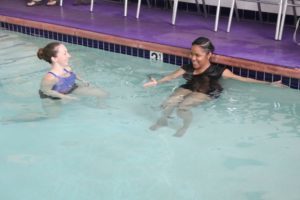
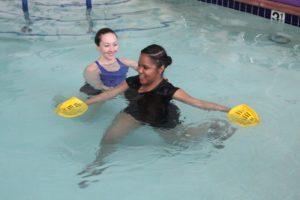
Back patients are braced against the side of the pool without resistance as they begin, then add resistance as they progress and finally step away from the wall.
Lower extremity distraction may also be a good way to reduce pain in a patient with radicular symptoms (pain that radiates down the leg). Having weight around the patient’s ankles will provide a traction force to the spine, elongating the muscles of the back and increasing joint space to decrease pressure on the spinal nerves. Contraindications include fractures, acute strains, lumbar instability, post-surgical status, pregnancy, and others. We typically use this method if the patient is unable to tolerate exercise because of severe pain, or if radicular symptoms do not improve after several weeks of aquatic exercise. See below for details on how to set up patients for distraction.
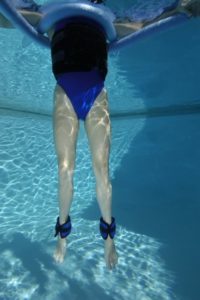
Distraction Technique
Belt goes on FIRST for safety
Use 2 belts if heavy weights
Put on ankle weights in shallow water
Noodle back to front first; front to back next; use extra noodles rather than extra belts
If knee sore, move backward, not forward to the deep water
Add more weight if patient does well
The pool is a great place to initiate the rehabilitation process for a wide variety of diagnoses involving low back pain. Keep in mind the patient’s diagnosis, post-surgical precautions, and current fitness level when creating the appropriate plan of care. The amazing properties of water will allow these patients to strengthen in an environment which may be more tolerable than land, resulting in a speedier recovery.
Katey Eisenstein, DPT, is originally from Pennsylvania and earned her Bachelor of Arts in Psychology at the University of Delaware. She received her Doctor of Physical Therapy at Florida Gulf Cost University where she had considerable experience in outpatient orthopedics as well as acute care and skilled nursing. She performs both pool and land physical therapy as the Clinical Director at CompletePT in Los Angeles.
Lynda Huey, MS, earned a bachelors and masters degree from San Jose State University where she also starred on the track and field team. Her own athletic injuries led her into the water where she learned to cross train and speed the healing of injuries. She has written six books on aquatic exercise and rehabilitation, books that are considered the foundation of aquatic therapy world-wide. Lynda is President of CompletePT Pool & Land Physical Therapy in Los Angeles.
September 14, 2017
From Linebacker to Orthopedic Surgeon and Humanitarian
Frantz Lerebours was a linebacker at St. Anthony’s High School, a perennial sports power house football team on Long Island, New York. For three years, the team had been undefeated in the regular season only to lose the championship game to Monsignor Farrell from Staten Island, New York. Now, in his senior year, he was the starting outside linebacker. His team was nationally ranked on USA Today’s top fifty high school football teams in the country. Once again they were playing Monsignor Farrell for the championship game.

Frantz Lerebours, star linebacker at St. Andrews High School, Long Island, NY.
“Two minutes left in the game,” Lerebours remembered. “We were up by two. They were punting. The middle linebacker Ted and I came off the left side together. He was bigger than me, but I was faster. He blocked a defender and I dove with my hands out. The football hit my thumb, then it hit Ted in the back and bounced right in front of me. I grabbed it. It happened so fast. I thought my dream had come true. We were about to be #1 in New York State. Yes, I put us in a good position to win, but our offense turned the ball over, and the other team kicked a field goal and won the game by a point. I haven’t told that story in years, but it’s still right there.”
That’s Frantz Lerebours – the one who remembers the moment of brilliance that lit up his heart and still smiles with excitement as he tells the story. He’s long since gotten over the huge disappointment of losing that game.
“I was recruited to play for several Northeast liberal arts colleges, but I knew I wasn’t big enough to be a professional. I’ve always been reasonable and practical. I was 5’10”, 200 lbs. and strong. But I could size up the other guys. There’s no way I could compete with them. They would have knocked my head off,” he says laughing. “I knew I was interested in academics. I spent the summer prior to my senior year of high school at Columbia University doing a genetics and molecular biology summer course. That was my first exposure to advanced science with a lot of cool genetic mapping with fruit flies.
“I came from a family of medicine, so in high school I was thinking I would be a doctor. I thought about ophthalmology, which is what my father did. I didn’t like the microsurgery aspect and the small surgical field. Plus I didn’t like being in the dark all day.”
Frantz Lerebours went to medical school at Howard University in Washington, D.C. and loved it. At his mostly Irish middle school, St. Patrick’s, he and his sister were the only two African-American kids. So it was a great experience for him to be in a school where the majority of the students were black. Howard University’s mission statement says they are training physicians to serve the underserved and take care of the community. That felt good to the doctor-to-be.
“A lot of times, the medical students at Howard are nudged into primary care, but I was part of the second class of Nth Dimensions’ summer internship program, which has a goal to increase exposure with women and minorities into orthopedics. Nth Dimensions is partnered with Zimmer, a medical device company, and for thirteen years, they have been providing scholarships for two- month orthopedic internships. I spent a summer with orthopedic surgeons William Long, M.D. and Larry Dorr, M.D. at the Arthritis Institute at Centinela Hospital in Los Angeles.
“It was the first day. I had never scrubbed into surgery before. I didn’t even know how to scrub. I mimicked what Dr. Long did and focused on not contaminating the surgical field. It was an overwhelming experience. I enjoyed watching the concerted movements as instruments passed from the surgical tech to the surgeon like an efficient factory assembly line. My heart was racing with the excitement as I watched the surgeon reconstruct a knee. I loved the fact that we weren’t giving this patient a pill or a lab result. I loved the immediate gratification of seeing the deformity of the knee on the X-ray before surgery, hearing the plan of how we were going to correct the knee a certain number of degrees to realign it, then seeing the post-op X-ray to see that we did it. And since I was seeing patients with Dr. Long for eight weeks, I got to see the patients who had surgery the first week walking independently by the eighth week and they were so happy. I loved it! It was that moment I knew I wanted to be an orthopedic surgeon.

Orthopedic surgeon William Long, MD (left) pictured with Dr. Lerebours as he scrubs for the first time in his career.
“After med school at Howard, I went back to NYU for my residency. It’s one of the biggest residency programs in the country with twelve residents a year, and it is known as a military-style program. They have high expectations, so if you mess up, they’re not afraid to tell you, believe me. They taught me to dot my i’s and cross my t’s. I remember putting a cast on a patient with a broken ankle, but the next day they saw on X-ray that it was slightly out of alignment. I had to call the patient back and have him come in again so I could correct it. Now I appreciate how meticulous they made the residents be.”
During that residency, Dr. Ron Israelski, CEO and President of Orthopedic Relief Services International (ORSI), asked the residency director at NYU to go along with his medical team on the next trip to Haiti. ORSI’s main goal is to help build back the orthopedic services at the largest hospital in Haiti after it was destroyed in a devastating earthquake. Frantz was the only person of Haitian descent doing the NYU residency, so they looked to him first to go along.
“I speak the language; my family is from there. When they offered me this opportunity, I didn’t hesitate. I said, ‘Sign me up.’”
Dr. Lerebours’ parents were Haitian Refugees in the mid-1970s and his ophthalmologist father set up shop on Long Island, New York. His dad had seven siblings, three who are doctors, three who are engineers. One stayed in Haiti and all the others moved to Florida, New York, California, and Canada. Frantz was born and raised on Long Island. He was immersed in Haitian culture with his family and cousins.
“Over the years, I watched how the Haitian economy declined and the corruption got worse and worse and the country become more dangerous. My parents never went back. Haiti is the poorest country in the Western Hemisphere with the worst history of natural disasters between earthquakes and hurricanes. When I visited, there were a lot of people displaced, living in tents. It was an eye-opening experience. My parents left Haiti on a whim back in the 1970s when things weren’t so bad yet. Sometimes I think about what my life would have been if they’d stayed there. That was an introspective experience to say the least.”
The statistics are staggering. With an island population of 11 million, the university enrollment rate in Haiti is slightly under 1 percent while 84% of all university graduates have left the country. The Department of State warns U.S. citizens to carefully consider the risks of traveling to Haiti due to its current security environment and lack of adequate medical facilities and response. Yet Dr. Lerebours travels to Haiti several times a year with Orthopedic Relief Services International.
“We don’t just go down there and do surgeries and leave. We want them to be self-sustaining and establish their own orthopedic residency program. We’ve been bringing down books and equipment over the last few years. My goal is to establish arthroscopy there. They don’t have the equipment. They recently got a tower, which is what the cameras and surgical tools are hooked up to, but they don’t have the tubing. Even saline is scarce. It’s so valuable because of the diarrhea and the diseases, that even saline to flush into a joint, which seems like no big deal to us, could be a very big deal there and save someone’s life if they’re dehydrated from cholera.”

Dr. Lerebours in Port-au-Prince, Haiti, during one of his earlier medical missions to the capitol’s public hospital.
While Dr. Lerebours travels to Haiti frequently, he has also stayed focused on his career. After his five-year NYU residency came an orthopedic surgery fellowship at the Kerlan-Jobe clinic in Los Angeles. He wanted to learn from the illustrious sports medicine faculty there – doctors such as Neal ElAttrache, James Tibone, Ronald Kvitne, John Itamura, and Clarence Shields. And it turned out he learned almost as much from the other fellows who were training with him.
“A lot of us were from the East Coast. We became very close and did a lot of our research together. We had unlimited access to the cadaver lab, so we had the luxury of being able to do nearly any surgery we wanted right there on site. That was invaluable. It’s one thing to watch an associate do a surgery and it’s another to have the ability to do the surgery yourself on a cadaver with the actual instruments that you use in surgery and work through some of the problem-solving issues.
“I got a lot of experience treating the injuries of hockey, baseball, and basketball players while at Kerlan-Jobe. The injuries that come with football and basketball are often seen in the community, but most of the problems that come from baseball are overuse injuries from throwing. That means treating baseball players is entirely different than treating hockey players. With hockey players, you just patch them up and get them back out on the ice. But with baseball players, you have to shut them down, and you’ve got to watch their pitch count. There are so many different injuries in baseball, and it seems like all the players have pathology. The intricacies of taking care of throwing athletes lie in the realm of knowing which to fix and which ones to treat conservatively. That’s the art. Dr. ElAttrache has that down to a science. He understands that if you surgically repair a shoulder, throwers may no longer be able to reach into the full range of the late cocking phase and they may never play again. He’s watched baseball players for years and he has a sixth sense that lets him easily pick out the problem. I learned a lot in during my fellowship that I now apply to the shoulder patients I treat.”
Following his fellowship at Kerlan-Jobe, he joined Cedar Sinai Medical Group and began working with the illustrious orthopedic surgeon and well-known radio talk show host Robert Klapper, M.D. Dr. It seemed Klapper, who for 30 years worked as a solo practitioner, was searching for another doctor to join him.
“It was a Saturday morning. I woke up and looked at my phone and I had a text message and voicemail from Dr. Klapper,” he says smiling. “We’d never met or talked before he said, ‘Hi, Dr. Klapper. I got your CV from Dr. Gabriel (orthopedic surgeon also at Cedars-Sinai). Come down and meet me at my Manhattan Beach studio around 10 o’clock this morning.’ I got dressed, hopped in my car and went down there. It was a hot morning. I walked up to his studio and saw all these beautiful sculptures. He came out wearing blue scrubs and gave me a big hug. It was a very relaxed meeting. He reminded me of back home – a very well-spoken New Yorker with a big personality. Bibi Vabrey, Dr. Klapper’s office manager, came walking by and joined us for an interview. At the end, he looked at Bibi and said, ‘I think we have our guy.’ Within two weeks, I was spending time with him, shadowing him. I was learning how he takes care of patients and how everything works at Cedars.
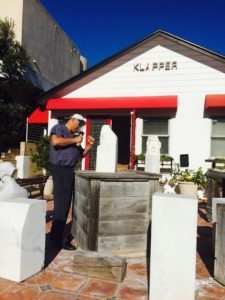
Dr. Klapper’s Manhattan Beach studio.
So for the past two years, Dr. Lerebours has been building his practice. Now is the time he gets to see patients coming back to him from surgeries he did in his first year. He gets to observe their return to sport, such as a former patient who recently emailed him.
Hello Dr. Lerebours,
Last year, you performed a hip arthroscopy for a labral tear I had in my right hip and on my last office visit, I asked you if I would be able to climb Mt. Kilimanjaro in a year. Your response: only if I send pictures. Yesterday, I returned from Tanzania where I spent almost a month tutoring members of the Masai tribe, building schools on the island of Zanzibar, and on July 14th (exactly 1 year, 1 month, and 1 day after my surgery), I summited Mt. Kilimanjaro, the highest mountain in Africa, one of the seven summits, and the tallest freestanding mountain in the world. Thank you for fixing me up and I hope you enjoy a few of these photos from my climb 
August 2, 2017
My Four-Minute Hike with Michelle Obama
I arrive at the Westridge Road Trailhead around 6:30am expecting the small parking lot to be empty as it is every Monday morning. Why there are so many cars at the trailhead? And what’s this police car doing parked at a 45-degree angle, sticking out into the street? Is someone being robbed?
The dirt lot, which holds nine cars is jammed, but with only about four black cars parked askew. I see an open spot, I try to pull in, but these cars aren’t following the usual routine and it’s not going to work.
“What’s going on?” I ask the woman standing by the first car. “Police activity?”
“No,” is all she answers.
“You guys know you’re taking up about five parking places, right?” I say.
No answer. I turn my car around and drive about 75 yards down the hill to street-side parking. There are two motorcycle cops standing and talking across the street. Good thing I have leashes in the car for my two pointers that usually jump out directly from the car onto the trail. Just as I get the first leash on Rosie, I hear the woman’s voice calling to me.
“Ma’am! We’re moving this car. Do you want to park here?”
“I do!” I answer and get back in the car to make my life easier.
I thank the woman and let Rosie and Angle out the back of the car. They race up the trail, knowing exactly where we’re going since we do this nearly 300 times a year.
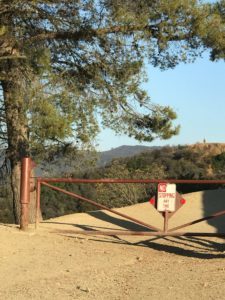
Start of the trailhead. Notice the trash can 400 yards up the trail.
Within a few minutes, we run into Jill, one of the “regulars” that I see almost every morning up here on the hill.
“Do you know what happened down below? I saw police cars.”
“Michelle Obama is here,” she says and smiles.
“Wow! You saw her?”
“Yes, I said, ‘hi’ and she said ‘hi.’”
“How cool! How far do you think they’re going?”
“I saw them around the oak tree, so they might be going all the way to the Nike tower.”
“Darn it! I came up here late so I could time it to get groceries afterward. I could have been here on time and seen her, too. I can’t believe I missed her.”
“Yeah, it was pretty cool,” Jill said. She walks back down to the trailhead and I continue up the trail, thinking how I wished I had been there at dawn as usual. How disappointing to have missed a chance to see the most elegant First Lady since Jackie Kennedy!
Next I run into Castela and her golden retriever, Beau.
“Did you see Michelle Obama?” I ask her.
“Yes,” she says excitedly. “There were lots of people around her. I recognized her, but I couldn’t remember her name. I pointed and said ‘I know you!’ Cort was with me. He was throwing the ball for Beau when they walked past.
Castela walks back down the trail and I keep going up, feeling myself fall farther and farther behind the group I would love to catch. Almost at the 1-mile mark is a sign designating this trail as part of the Santa Monica Mountains Conservancy. This had been my intended turn-around point before I heard we had impressive company on our trail. If I turn around now, there’s no chance I’ll see the Obama group even as they come back down the trail. Maybe if I go to “The View,” as we call it, I’ll see them coming back down. It’s warmer than usual even for early in the morning, and I don’t have water for the dogs, but this is a special event and I decide to stretch us all a bit to make a try for an historic sighting of political royalty.
I run into Debra and her golden doodle Charlie. She’s buzzing with excitement.
“I saw her,” she says, assuming I know what’s happening. “I spoke with some of the secret service guys at the trailhead and heard them announcing the people who were coming up the trail to the other guys on their team.”
“Wow, looks like I missed her. Doggone it!”
“Yes, it’s thrilling to have her here with us.”
I keep going, but several times waiver, ready to admit defeat and simply slink back home. But each time, I remind myself that I had decided to go to The View, so OK, I’ll go to The View.
Luckily for Rosie and Angel, we run into Cort and Michael, two more regulars. Michael has a bottle of water with him and is happy to give my girls a drink. Both men eagerly tell me about seeing Michelle and her group of eight to ten people.
“They’re moving at a really good speed,” Cort says.
I thank Michael for the water and once again convince myself to do what I said I was going to do – go to The View. When I get there, a prominence overlooking the entire area, I don’t see anyone on the trail. I can see 100 yards down this short drop in the fire road to the oak tree, which is the 2-mile mark, before it starts to climb once again. I stop and stretch, stalling in hopes that the fast-moving group will suddenly appear, but no such luck. Oh well, I tried. I start back down, accepting what had seemed like inevitable defeat. I think of how often I had seen people electrified by seeing Wilt Chamberlain during my many walks, hikes, bikes, runs, and racquetball games I had with him. At breakfast once with Wilt, we spotted baseball star Reggie Jackson in a booth on the other side of the restaurant. “I wonder what he’s doing here,” I said. Wilt’s response: “Everybody’s got to be somewhere. I suppose that was his summary of dealing with fame. Just seeing Wilt jolted people with energy just as I’m seeing here on Westridge Trail over Michelle Obama. I may have missed her, but I’m seeing her presence in my friends’ exhilaration.
After a drink, the dogs happily race up and down on the trail as we move closer and closer to the car. I spot some dog poop another hiker left on the trail, so I bend to pick it up. Cold. Not my dogs’. The trash can that is nearly 400 yards from the end of the trail is in sight. I won’t have to carry it far.
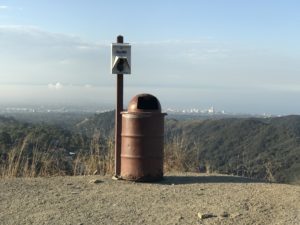
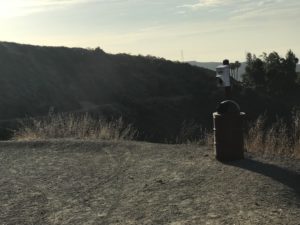
The trash can overlooking Santa Monica Bay . Looking to the trailhead 400 yards from the trash can.
I toss it in the can and feel a presence behind me. Another hand discards something into the same can. I turn to see who and it’s Michelle.
“I was hoping to see you!” I say and she smiles. I point at her and say fiercely, “I miss you!!”
“We miss…” A pause. I picture the White House. I wonder what she’s picturing. She censors herself and says “Well, we get to do things like this.”
We both turn and keep walking toward the cars. We fall into step. A baseball cap and sunglasses protect her from the sun. She’s wearing a tank top and over-the-knee tights. I’m in shorts since it’s so hot and humid.
“How did you find this trail?” I ask her.
“My friend,” she says pointing to the blonde man in the first row of two hikers. Michelle and I are in the second row of four. Her younger daughter is in the third row of four and there’s a fourth row of two behind them. There’s only one other woman beside the two Obama women.
Her friend turns his head toward me as we all keep walking at a good pace. Friend: “Would you please tell her this is more humid than usual?”
LH: “Yeah, it’s really muggy.
MO: (With resignation) “Oh, well.”
LH: “I know it’s not like Florida where I was recently.”
Blond Man: “Or D.C,”
LH: “Yeah, I lived there a year and D.C. is brutal.”
Blonde Man: “You can cut that humidity with a butter knife.”
MO: “That’s the one I’m talking about.”
A few more steps and a change of topic.
MO: The dogs get to be off leash?
LH: Yes, it’s one of the few legal off-leash trails for dogs.
MO: “Do you think Bo and Sunny would like it here?”
It seems like she’s asking her friend in front, but after a beat with no answer, I jump in.
LH: All dogs love it here. But I have never seen a Portuguese Water Dog yet.
MO: What breed are these dogs?
LH: They’re English Pointers, really sweet dogs.
My dogs usually roam 50-150 meters ahead of me, but when I fell into step with this large group, they are hanging back, feeling something is different. Yes, something is different – I’m hiking the last quarter mile of the hike with the former First Lady of the United States!
LH: Come here, Angel.
Angel eases up in front of us but keeps moving at our pace.
MO (pretending to speak for Angel): What have you got for me?
LH: I’ve got a treat.
And I hand it to her.
MO: How often do you come up here?
LH: Every morning.
MO: What a great way to start the day.
LH: Yes, the sunrises are spectacular.
We curve toward the last straightaway before the parking lot.
LH: You know, I hung out with Wilt Chamberlain for almost 30 years, and the buzz you guys created on this hill is the same as it would have been if Wilt had walked through here.
MO: (laughing) He would be pretty recognizable.
LH: I know! We were in Helsinki together and some guy way across the street is yelling, “Wilt!”
MO: He would be hard to disguise.
LH: Right a baseball cap and sunglasses wouldn’t be enough.
MO: (Chuckling) And he couldn’t pull his hair back in a ponytail.
We’re almost to the parking lot and Rosie and Angel have run ahead. I have to keep an eye on them so they don’t cross paths with a moving car. One last thing to tell her:
LH: Your staff was really nice to us this morning.
MO: That’s good to know.
And then before I can load the dogs into the car and close the power door on the back, they are mostly gone and on the move. I watch the motorcade driving down Westridge Road. I take my usual short cut down Banyon, Arbutus and Chalon to Mandeville Canyon. At the stop sign, I meet up with the motorcade that’s turning toward Sunset Blvd. We all turn left on Sunset and I snap a dozen pics of the cars moving east hoping one turns out OK. One almost did.
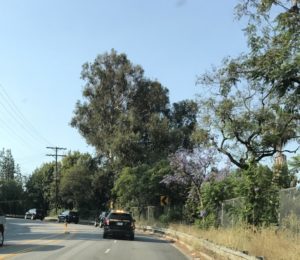
Michelle Obama’s motorcade driving east toward Beverly Hills on Sunset Blvd.
A text from Jill who told me about Michelle being there asks me if I saw her. “Yes, I hiked and talked and laughed the last quarter mile of the hike with her,” I text back. Incredible. After thinking I’d totally missed my chance to see her like the other regulars had, I’m the one who got to slip into her circle for a few brief, blinding moments.
Jill texts back, “You can tell me all about it tomorrow.” But my plan is to get out of the heat by going down into Sullivan Canyon, the adjacent trail. I text that to her, but then an hour later remember that I told Michelle I go there every day. What if she comes back again? I text Jill that I’m be there on the trail tomorrow.
The regulars are waiting in a pack in the wide open space in the trail at the half-mile mark. They want to hear every word. What did we talk about while we hiked? I told them. Did the secret service guys get nervous? No, it was the end of the hike and they were all probably tired after walking 8 miles in the heat. My exuberance must have allowed them to let down their guard or maybe they thought I knew Michelle. Maybe I was one of a million donors that Michelle couldn’t possibly remember. At any rate, I didn’t feel any tension in the air as I joined their group. I didn’t feel anyone pushing me out. Maybe my years of hanging with Wilt had taught me not to intrude with anything personal. Stick with the weather and dogs. No photos, no autographs. Those were the things Wilt hated from strangers.
For several days on the trail, Michelle’s visit was the prime topic of conversation. Then things gradually got back to normal.
Sequel
Thirteen days later on a Sunday morning, I’m up on the trail at dawn and see the black cars in the dirt parking lot again. This time one is half blocking the entrance, but I can squeeze past. Two more are backed into real parking places, but ready for a quick exit if needed. The fourth Ford Explorer is parked on the street and one female and two male agents are standing beside it. I let Angel and Rosie out of the car and say to the woman, “So Michelle is back, huh?” She smiles but says nothing.
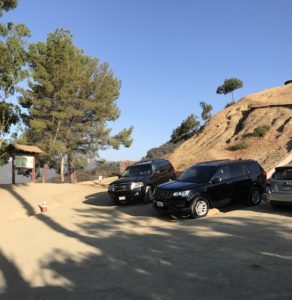
I start up the trail. About five minutes into the walk, an athletic man in his twenties walks by. I see the coiled earpiece and say, “You’re bringing up the rear?” He answers, “Now I have to go catch them.” We laugh.
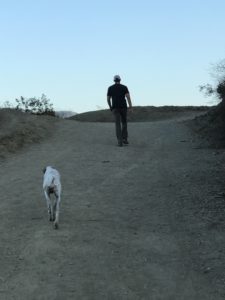
Jennifer, an early-morning regular, comes running down with her two pooches Jumps-A-Lot and Phyllis. I give them both treats while she tells me excitedly that she saw Michelle.
“I saw two guys with back packs, then my eyes were drawn to her – she’s tall. I said, ‘good morning,’ and she said, ‘good morning’ back. It wasn’t until I was already past her that I realized who it was. There were two more secret service men following. I asked, “Is that who I think it is?” They smiled and said “we don’t know what you’re talking about.” Jennifer is lit up with excitement. We chat, then she keeps on running.
Next I encounter Charlie, a week-end regular with his two Australian sheep dogs Atlas and Ranger. Charlie heard Michelle is on the mountain somewhere, but didn’t see her. He figures she must have gone to the top 4 miles up because he turned around at the 2-mile mark and didn’t see her.
This morning I don’t have time to go beyond the sign, which is the 1-mile turnaround point for me. I don’t need to see her this time. I had my brilliant moment with her and know very well that that Spectacular First Meetings can often lead to Disappointing Second Meetings. I’ll hang onto my tale I’ve written. But we can always hope she’ll decide to become one of our regulars and hike with us every time she’s in L.A. Maybe Angel and Rosie will even get to meet Bo and Sunny.
After all, like Wiltie said, “everybody’s got to be somewhere.”
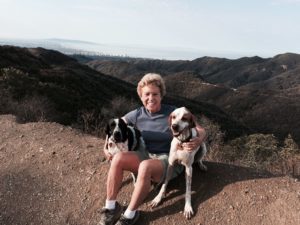
Rosie and Angel
Water Rehab Specialist, Lynda Huey, MS, earned a bachelors and masters degree from San Jose State University where she also starred on the track and field team. Her own athletic injuries led her into the water where she learned to cross train and speed the healing of injuries. She has written six books on aquatic exercise and rehabilitation, books that are considered the foundation of aquatic therapy world-wide. Lynda is President of CompletePT Pool & Land Physical Therapy in Los Angeles.
May 10, 2017
AgeProof Your Hips
By Robert Klapper and Lynda Huey
Hip pain can strike at any age – from fire fighters and stunt men and women in their 40s, to every day runners and tennis players, to less active people in their 50s, 60s, 70s and upward. Maybe you came home from a hike and suddenly discover a deep ache in your hip. Or maybe your hip has been bothering you off and on for weeks. Pain might be keeping you awake at night or perhaps you’re starting to limp. You want relief!
You want to find things you can do that will let you fight back against Father Time. Even if you’re not feeling that old yet, your hips might need you to make that effort starting now.
Reduce High-Impact Activities
Here’s something you can do right away: modify your sports and fitness routine. Use water workouts, bicycling, and elliptical training as your daily fitness work and save any high-impact sport you can’t bear to give up for soul-satisfying special occasions.

Strengthen the Muscles Around Your Hip
The gluteal muscles of your buttocks are the key to having a strong, well-functioning hip. Strong gluteal muscles can keep you walking without swaying or limping. Get a program of key exercises from a trainer, physical therapist, or the book Heal Your Hips and do them every day.

Increase Your Hip Flexibility by Stretching
Stretch the muscles at the front, the side, and the back of your hips. Do your stretches every day, even if it feels like you have little flexibility. Doing small steps consistency leads to progress. Flexibility leads to improved mobility in daily life.

Lose Weight
If you are overweight, your weight-bearing hips pay a heavy price in increased wear and tear on the precious cartilage inside. Osteoarthritis is the loss of cartilage inside a joint – why contribute to its deterioration?
Start AgeProofing your hips now and start feeling better every day.
Orthopedic Surgeon Robert Klapper, MD, is a leader in joint replacement at Cedars-Sinai Medical Center. He is the host of ESPN radio’s “Weekend Warrior” show and a sports medicine expert on Fox Sport 1 TV. He has written three books with Lynda Huey.
Water Rehab Specialist, Lynda Huey, MS, has written six books on aquatic exercise and rehabilitation, which are considered the foundation of aquatic therapy world-wide. Lynda is President of CompletePT Pool & Land Physical Therapy in Los Angeles.
May 2, 2017
Lumbar Disc Replacement Surgery Goes Outpatient!
By Lynda Huey
At 5 AM on Thursday morning, March 16, 2017, spine surgeon Alex Rasouli, M.D. performed the first outpatient surgery to replace a lumbar disc with an artificial disc at levels L4/L5. Although Dr. Rasouli humbly called it “the first in this area,” a search of the internet and phone calls to leading spine centers in Los Angeles and around the country did not turn up a single mention of the surgery being performed on an outpatient basis. This could be the first such surgery or at least one of the very first performed anywhere.
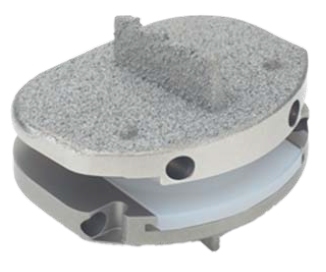
Why is that such a big deal? Actually, it’s two big deals. The first revolutionary change was switching from lumbar fusions to disc replacements. Until recently, the traditional way of treating people who had unmanageable, intractable back pain due to the failure of a disc between L4 and L5 was fusion. Spine surgeons would remove the disk and put in a spacer of bone or plastic, attaching several vertebrae together with screws and rods. That procedure stopped the movement and in many cases also stopped the pain. But sometimes the fusion didn’t heal solidly, and since it was an unnatural thing to fuse a level that was designed to move, issues often arose with the disc above or below the fusion, because those levels now had to compensate for the lost movement. So disc replacements were introduced about ten years ago. They met a lot of controversy because the first few disc replacement devices were failures. The device would come out, or the movement would not be restored, or even worse, some patients had more pain after the surgery than before. Newer-generation devices from multiple companies came out but had trouble getting FDA approval. When the approval finally came, there was trouble getting insurers to pay for it. Medicare, Blue Cross, Aetna and others weren’t paying for the artificial disc replacement surgery, because they still had the bad taste in their mouth from the previous generation of disc replacement devices. Now, as more and more surgeons are doing disc replacements, insurers are becoming more and more willing to accept this new technology, and therefore pay for it. They’ve begun to conclude along with the surgeons that the advantage of disc replacement is that you’re not taking away motion, you’re restoring motion. It’s more natural and has a faster recovery than fusions.
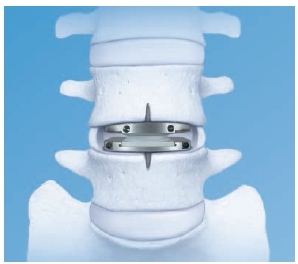
The Prodisc-L is designed to restore normal range of motion in the spine, which can potentially decelerate disc degeneration at adjacent segments of the vertebrae.
The second even bigger big deal is that Dr. Rasouli did this L4/L5 disc replacement in an outpatient setting. He says, “I want people to know that the next five to ten years of spine surgery will be like this: you show up, have your spine surgery, and go home the same day. That was unheard of five years ago, but it’s what we’re doing now. Small surgeries will replace big surgeries, outpatient surgeries are going to replace inpatient surgeries, short recoveries are going to replace long recoveries, and artificial disc replacements are going to replace fusions. That’s the paradigm of the spine for the next five or ten years. Our job is to be the vanguard of this spine movement. We like to avoid surgery as long as possible, but for those few patients on whom we choose to do surgery, we’d rather do smaller surgeries, outpatient surgeries, and disc replacements.
The next five to ten years of spine surgery will be like this: you show up, have your spine surgery, and go home the same day. — Alex Rasouli, M.D, Spine Surgeon
“There’s inertia in the delivery of health care. It takes a while to get things moving. If we can tell the insurance companies that we can do a procedure in an outpatient setting, which costs a lot less than doing it in a hospital, they’re more willing to go along. The patient is much better, because they don’t spend time in the hospital; they go home. They’re not getting fused. They don’t have to wait three to six months for fusion to occur. They’re doing physical therapy within two to six weeks, and they’re getting back to their lives much more quickly.”
Moving from the hospital to an outpatient surgical center was not a step taken lightly by Dr. Rasouli. He said, “I’ve been studying the technique that we’ve been doing in the inpatient setting (in the hospital) for the last five or six years and documenting how much blood loss we had, how long the surgery took, and other details. The L4/L5 surgery used to take two or three hours in the hospital. But once we got the surgery under 30 minutes and less than 5 ccs of blood loss consistently, we decided to do it outpatient. It just takes practice, skill set, and a new mentality that these surgeries can be done in an outpatient setting. There are still cases that are totally and exclusively appropriate for the hospital setting. But these smaller, one-level spine surgeries of the neck or the back are getting to the point where it’s a waste of society’s dollars to do them in the hospital.
Why is the L4/L5 disc so hard to operate on? At L4/L5 level, the blood vessels are running down the center of the body and somebody has to physically move them to the side for the operation on the disc. It takes a team of two equally-skilled surgeons, a vascular surgeon and the spine surgeon, to take part in this advanced surgery.
Dr. Rasouli says, “The incision for the outpatient surgery is about two inches long. For the vascular surgeon to give the spine surgeon safe access to the vertebrae takes about fifteen minutes. Then the actual removal of the damaged disc and replacement takes another fifteen to twenty minutes. The incision heals in a week to ten days. The tissues under that incision have faced minimal trauma at the hand of the surgeon. We don’t go through them or cut them. We exploit the natural anatomical planes of the body to go where we need to go. The tissues separate easily when we’re in a plane. When we’re finished, they fall back into their natural arrangement of layers. It’s not a matter of the tissues between the skin and the spine having to heal.
This first patient to undergo outpatient L4/L5 surgery walked out of the surgery center that same day. The day after the surgery, he had a little more pain than the day of surgery because the anesthetic was wearing off. His pain was at the incision in the front of the abdomen and at the back where his anatomy had been restored. A week later, most of what he had left was soreness in the back. Two weeks later, there was less soreness in the back.
Without physical therapy the surgery fails.
–Alex Rasouli, M.D., spine surgeon
 Dr. Rasouli continues the update, saying, “About a month to six weeks later, most of the symptoms he’s having are incisional pain in the front, but overall he’s doing very well, walking, sitting, driving, going to work. I asked him not to do any heaving lifting, nothing over fifteen pounds until he finishes physical therapy, which starts six weeks after surgery and continues twice a week for six weeks. Without physical therapy the surgery fails. This is not a fusion; this is a motion restoration procedure and unless the body is trained on how to use that motion, it won’t work. Some patients who have had a fusion will say, ‘I don’t need physical therapy.’ And they might be just fine. But the patients who have disc replacement are different. If they don’t do physical therapy, we’ve just wasted everybody’s time.
Dr. Rasouli continues the update, saying, “About a month to six weeks later, most of the symptoms he’s having are incisional pain in the front, but overall he’s doing very well, walking, sitting, driving, going to work. I asked him not to do any heaving lifting, nothing over fifteen pounds until he finishes physical therapy, which starts six weeks after surgery and continues twice a week for six weeks. Without physical therapy the surgery fails. This is not a fusion; this is a motion restoration procedure and unless the body is trained on how to use that motion, it won’t work. Some patients who have had a fusion will say, ‘I don’t need physical therapy.’ And they might be just fine. But the patients who have disc replacement are different. If they don’t do physical therapy, we’ve just wasted everybody’s time.
“There are a number of reasons why I made such a big push for outpatient surgery. The main reason is because in this environment where it’s so results oriented, the efficiency and value of the care is what everyone looks at – the government, Medicare, the insurers, and the patients. So we need to look at how much good we can do for all of them with the minimum amount of resources. The outpatient setting is perfect because it uses a fraction of the dollars that would be spent if we did the same procedure at a full-fledged hospital.”
Dr. Alex Rasouli has raised the bar high for his colleagues. His steady precision and methodical increase of skill until he was confident enough to do an L4/L5 disc replacement in the outpatient setting will create waves in the orthopedic and neurosurgery world. Let’s watch everyone try to reach the height of the bar.
Water Rehab Specialist, Lynda Huey, MS, earned a bachelors and masters degree from San Jose State University where she also starred on the track and field team. Her own athletic injuries led her into the water where she learned to cross train and speed the healing of injuries. She has written six books on aquatic exercise and rehabilitation, books that are considered the foundation of aquatic therapy world-wide. Her Aquatic Rehab Online Course is being studied by students in 15 countries. Lynda is President of CompletePT Pool & Land Physical Therapy in Los Angeles.
August 18, 2016
Watching the Olympics with Wilt Chamberlain
By Lynda Huey and Alan Silber
A conversation between Lynda Huey and Alan Silber on the occasion of what would have been Wilt’s 80th birthday, August 21, 2016.
LH: NBC tried something new in 1992. They called it the Triplecast – they offered three live-feed channels from every Olympic venue called the Red, White, and Blue Channels. Viewers could pay for one, two or all three of the channels, depending on which sports they wanted to see. What it meant for those of us in the sport of Track and Field, we could watch every heat, semi, and final of every race. We could see every qualifying jump, every throw of the javelin and discus. We wouldn’t miss a thing. It would be like being in the stadium for every minute of competition.
One catch, since it was live, and since the 1992 Olympic Games were in Barcelona, we had to live on Barcelona time, which is nine hours ahead of Los Angeles time. That was fine with Wilt Chamberlain, who was a night owl and slept very little. And it was fine with me and my good friend Alan Silber, who could get up in the middle of the night to watch the morning sessions in Barcelona. Many other friends would join us at Wilt’s house in Bel Air for a day or two here and there.
Left to right: Patty Van Wolvelaere, Wilt Chamberlain, Lynda Huey, during the 1992 Barcelona Olympic Games.
Wilt liked company when watching his favorite sports, so I planned to move in for the Games. We invited Alan to come watch with us. He said he could get away for the second week of the Games, the week of track and field.
For the Opening Ceremonies, Wilt threw a big party and we all invited our friends. He cooked, really cooked for us – ribs, a rack of lamb, some steaks, and I made his favorite fried chicken. Cybill Shepherd was my new best friend, so she was there as were Wilt’s best friends from the beach volleyball world.
What I remember most about that night was Wilt cruising around the huge, round dining room table with the giant chandelier overhead, pans of meat in his hands, serving up some scrumptious food. Sweat was dripping off his face as he focused on getting hot steaming ribs onto each of our plates. With Wilt, I always brought the vegetables to cook, or else there wouldn’t be any. He loved his meat. I loved my vegetables, and together we made many great meals together.
Most of the people at his home that night had never been there before, so I gave a few tours as people’s jaws dropped open, amazed at the height and size of the main rooms. They knew something was different about the house, but no one could quite place it, the fact that there were no 90-degree angles anywhere in the house. No regular, right-angle at the corners of the rooms. And they were all wowed by the huge triangular skylight that could slide back to see the night sky over his 9-foot by 9-foot bed.
When track and field began, we got serious about our sports watching. Track fans joined us for a few hours or a whole day. They made sure they were at Wilt’s place to watch their favorite events to be part of the raucous group that talked louder than the NBC commentators.
We were up just before 2am every morning (11am in Barcelona) to watch the morning heats in the track events and the qualifying rounds in the field events. Some of the friends arrived just before 2 to join us. It was an odd time table, but we all were loving it. Wilt didn’t sleep much, but the rest of us usually took a nap just before dawn when the first half of the day’s viewing was complete. Then we were back at it at 10am our time (7pm Barcelona time) for the night’s semi finals or finals. Now and then we’d get a call from friends at the stadium who would call in their inside stories to us.
AS: I arrived for the first day of the track and field. I had sat next to Wilt in Montreal in 1976, and knew he was “a track nut” with a long history in the sport. Our lives for that week revolved around Olympic track and field events. I told Wilt that when I’m at home in New York City, I watch sports events while riding my exercise bike. Wilt set up his exercise bike for me in his huge bedroom, and I rode while watching the Olympics. Wilt and Lynda were lying on the bed while I rode and drank seltzer. The scene was a trifle surreal, but big time fun.
Lynda took us through a workout every day in Wilt’s pool. The workouts grew in size. I think the largest one was about twelve people. Wilt cooked – and how! He was a great cook! One night when I went out to eat with a friend, my rule was that we could only dine at a Spanish restaurant.
I am a hoops lover and follow basketball closely. Lynda never loved basketball (much to Wilt’s chagrin), so she would go do other things while Wilt and I watched all the basketball games. The Barcelona Olympics was the year of the “Dream Team” – the first time professional basketball players competed along with the college kids. Both Wilt and I were admirers of the Lithuania team who were wearing uniforms by the Grateful Dead. Wilt especially appreciated the play of Arvydas Sabonis, the Lithuanian 7 footer, who knew the game and was an adroit passer from the post. I had the privilege of talking to arguably the greatest center to ever play the game about the intricacies of how to play the position and why Sabonis was so good. Watching those games with Wilt – just the two of us – analyzing every play was something I will never forget.
During half time of a Lithuania game, I had the opportunity to talk with Wilt about one of my all-time favorite basketball games – the 1957 NCAA championship game between Wilt’s Kansas Jayhawks and the undefeated University of North Carolina Tarheels. I was a freshman at Duke and was intimately familiar with the Carolina team and its miraculous season. UNC had made the finals in a thrilling triple overtime game against Michigan State. Now they had to face Kansas, who was a heavy favorite. That game was yet another thrilling triple overtime game where Carolina cemented its undefeated season with the National Championship. Wilt remembered every play and said it was a loss that still rankled. He verbally replayed the game to me. I was thrilled to listen. What a memory he had of the whole game!
LH: I remember walking in one time while you two were watching a basketball game and neither of you even knew I was there. You were bantering back and forth so furiously with such heat, that I just listened for a while. I smiled at how much you two were enjoying the fast verbal company, then I walked right back out.
AS: That was one of the best weeks of my life. We went from watching one sport to another and called it life. We just lived in that sports world, doing workouts and watching competition – that was so wonderful. There was nothing in the real world that intruded. I loved that we could see every single moment of track and field. I mean, we saw every throw in the hammer throw, including the first round. It was such a difference from the way the Olympics are covered now. You look at these Olympics of 2016: it’s so American-centric. It’s as if there aren’t any athletes worth talking about except Americans. But watching that Triplecast was totally neutral. They didn’t give you a medal count. They simply told you the lane assignments and what the athlete in each race had done that year and in previous years. It was sport in its purist form. That week still stands as a golden memory.
LH: The coolest part of our week of “Livin’ on Barcelona Time,” was having guests show up at the front gate just before 2am for the “morning” sessions at the Games. Several mornings in a row, Trond Woxen, a former Norwegian Olympic athlete, arrived exactly two minutes before 2am. Had had been a Modern Pentathlete, skilled in fencing, 200M freestyle swimming, show jumping, pistol shooting, and a 3200M cross-country fun. Wilt enjoyed quizzing him about each of the lesser known events and quizzed him on his training regimen. Trond added humor to our gathering and gave us a phrase we will forever use when watching the Olympic Games: “Raised by Wolves.” He hated all the athlete profiles that showed how tough their lives had been before they found track and field and jumped into the Olympic spotlight. Whenever he saw such a profile coming, he would yell, “Raised by Wolves!”
Patty Van Wolvelaere, the former American Record Holder in the 100M hurdles, came to stay for the two days of the women’s hurdles competition. She had been my former roommate and star of Wilt’s WonderWomen Track Club in the mid-1970s. Patty, Wilt, and I had hung out together at many a track meet or night club. Wiltie loved her company and always became more animated in her presence.

Left to right: Lynda Huey, Wilt Chamberlain, Patty Van Wolvelaere
At a UCLA track meet, 1974.
I moved over to give Patty my place of honor to Wilt’s right on the big bed. Some days or nights, there were five or six people watching the huge TV from that bed. It was a giant sports slumber party.
Watching the games twenty-four years after that magical week in Bel Air has brought back many of those memories. I stopped watching the Games when Wilt was gone, but this year, my interest was re-awakened. Now the memories are back and it’s time to celebrate Wilt’s would-be 80th birthday.
Water Rehab Specialist, Lynda Huey, MS, earned a bachelors and masters degree from San Jose State University where she also starred on the track and field team. Her own athletic injuries led her into the water where she learned to cross train and speed the healing of injuries. She has written six books on aquatic exercise and rehabilitation, books that are considered the foundation of aquatic therapy world-wide. Lynda is President of CompletePT Pool & Land Physical Therapy in Los Angeles.




